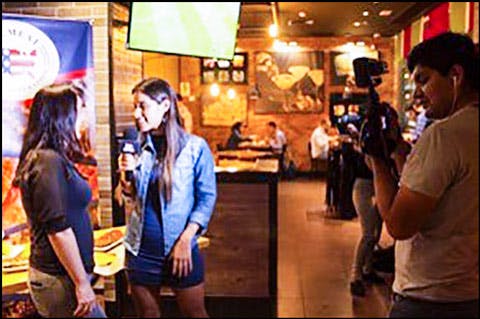Festival Builds Awareness for U.S. Pork Ribs in Peru
USMEF partnered with a leading pork importer and foodservice distributor in Peru to conduct a two-week-long “U.S. Pork Ribs Festival” at seven restaurants in the capital city of Lima. The promotion with Inpelsa, which supplies U.S. pork spare ribs, St. Louis ribs and baby back ribs to the region’s foodservice sector, was funded by the National Pork Board.

This poster promotes the U.S. Pork Ribs Festival at one of the seven participating restaurants in Lima
“The event was designed to encourage Inpelsa’s clients to include more U.S. pork dishes on their menus,” explained Jessica Julca, USMEF representative in South America. “We took an inclusive approach to the promotion in order to reach different types of foodservice clients and their customers. But first, to draw attention to our efforts, we arranged a preview luncheon for the local food media to help spread the word.”

Jessica Julca, left, USMEF director in South America, is interviewed on-camera during the U.S. Pork Ribs Festival
The luncheon was held at Swissotel Lima, where Zorim Wong, executive chef at La Locanda restaurant, prepared flavorful U.S. pork rib dishes for about 25 writers, photographers and social media content producers. USMEF also organized a tour of participating restaurants that included tasting samples and demonstrations by chefs on how to prepare dishes featuring U.S. pork ribs.

The U.S. Pork Ribs Festival taught Peruvian foodservice professionals and consumers more about U.S. pork and pork products
The pre-event publicity generated from the luncheon resulted in more than 60 newspaper articles, social media posts and television segments.
“This created great awareness of the U.S. pork products available, as well as the establishments in Lima serving U.S. pork,” said Julca. “USMEF received several commercial leads inquiring about U.S. pork through the USMEF-South America Facebook page, which were passed on to the importer.”
As part of the U.S. Pork Ribs Festival, USMEF trained kitchen staff and servers at all seven participating restaurants on the key attributes of U.S. pork.
To encourage repeat customers and increase dining frequency during the promotion, USMEF created a program called the “Pork Passport.” Diners received a special stamp from each participating restaurant they visited. Once four of the seven stamps were acquired, the diners could apply on USMEF-South America’s website for a chance to win a special barbecue kit containing the three types of U.S. pork ribs featured during the festival.
Julca said follow-up discussions with participating restaurants revealed a 20 percent increase in U.S. pork sales during the promotion compared to the same two-week period the previous year.
“The numbers were up, but an even more important outcome from the event is that we were able to increase awareness of U.S. pork,” said Julca. “The promotion was an opportunity for many consumers to taste U.S. pork, and we educated many foodservice professionals on how to prepare U.S. pork dishes and share information about U.S. pork with their customers.”
